“Easy to know that diamonds– are precious good to know that rubies — have depth but more–to see–that pebbles–are miraculous.”
Josef Albers


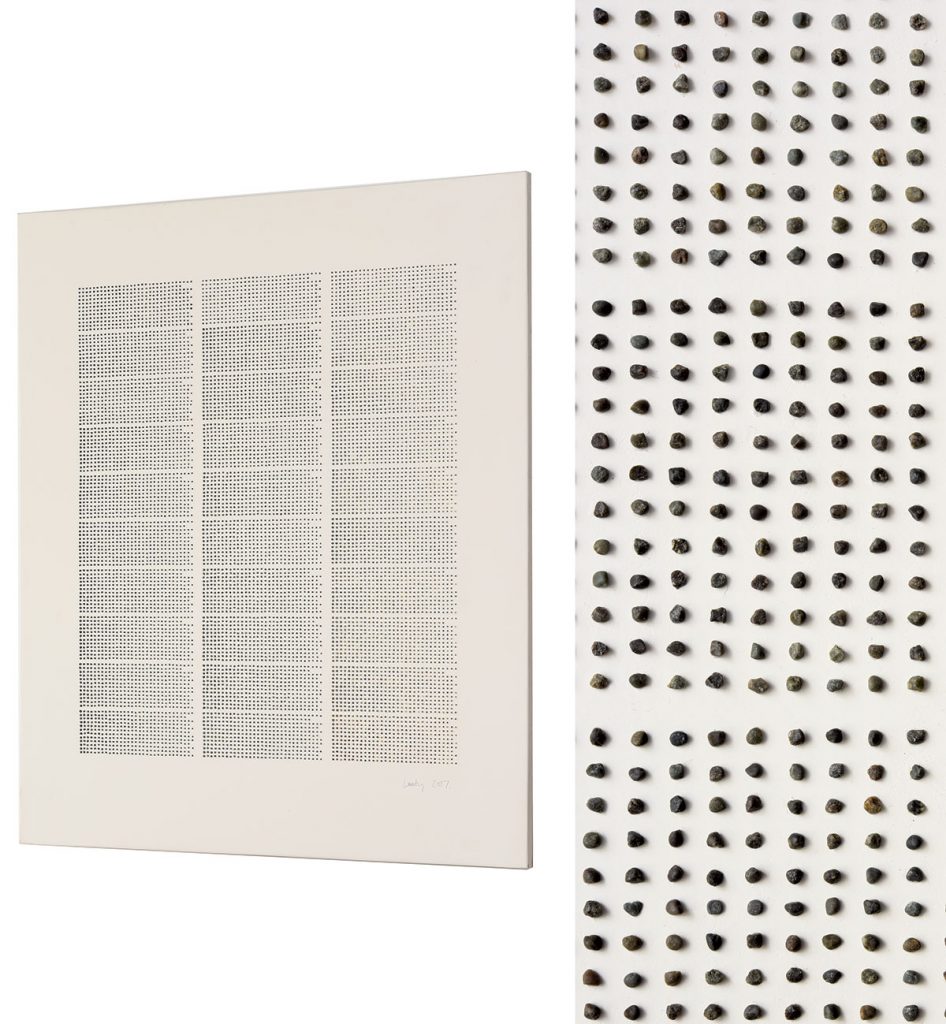
“Easy to know that diamonds– are precious good to know that rubies — have depth but more–to see–that pebbles–are miraculous.”
Josef Albers



‘Our tactile experiences are elemental’
I was eleven when On Weaving was first published. I was making dens in the woods and wondering what I’d be when I grew up.

Years later Anni Albers’ seminal book was to become pivotal in the development of my teaching and thinking. I actually bought it in 1983 from the Museum of Fine Arts in Boston, $8.95, black and white, paperback. Yet it wasn’t the images that first grabbed me, but the four pages of chapter eight: Tactile Sensibility. The phrase “tactile sensibility” was new to me, and even if in my fingertips I knew there was such a thing, I’d never heard it named before and given a serious discourse.

Of course, many important influences shape us as we carve our creative journey, not least Beyond Craft: The Art Fabric, Mildred Constantine and Jack Lenor Larsen’s groundbreaking publication and the first art book I ever bought. However, it was Anni Albers’ rigorous unpicking of the intrinsic relationship between the structure of weaving and the fibers chosen that fired a key part of my working ethos; as she put it “…the inner structure together with its effects on the outside …the engineering task of building up a fabric …developing the vocabulary of tactile language.” read her words over and over and used them in teaching alongside practical workshops informed by her open, questioning approach. I still do.

Visiting the fabulous Anni Albers exhibition at Tate
Sue Lawty
December 31, 2018
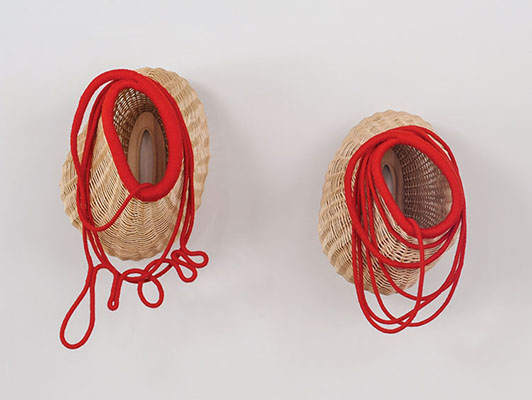
Paniers-liens III, Séphanie Jacques
carved wood (ash), white willow, hemp rope, red, wool, 21.25” to 43.25” x 15.5” x 17.75”,2011.
Paniers-liens II, Stéphanie Jacques
carved wood (ash), white willow, hemp, rope, red wool, 22” x 17.25” x 17.25”, 2011
Earlier this year, we compared Artsy‘s list of fiber art pioneers and ours (see also Craft in America’s Pioneering Women in Craft). In the years since contemporary fiber first gained international attention, a group of younger artists have continued to experiment. Numerous artists from a decade or two or three later are identified as continuing innovations in this field, including Rosemary Troeckel, Lesley Dill, and Ernesto Neto and more recently, Sophie Narrett and Orly Cogan.
Of the artists that work with browngrotta arts, we’d point to five who continue to redefine the practice. Stéphanie Jacques of Belgium, combines clay, wood, photography, knitting and basketmaking to create works that reveal what is unseen.
Federica Luzzi of Italy, uses fiber to illustrate natural phenomena. Her current series of elegant macramés were born of conversations with researchers at the National Institute of Nuclear Physics in Frascati, Italy about concepts of dark matter, antimatter, nuclear, subnuclear physics and the particle accelerator.
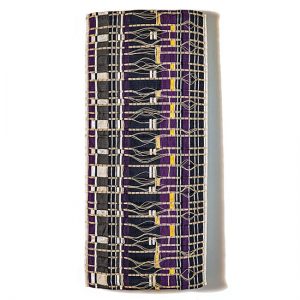
Transición, Eduardo Portillo & Mariá Eugenia Dávila, alpaca; metallic yarns and silver leaf; moriche palm fiber, silk, 56″ x 24.25”, 2018
Eduardo Portillo and Maria Dávila from Venezuela take an experimental approach to all aspects of their work — sourcing, technique and materials. The artists spent several years in China and India studying sericulture, or silk farming, and since then their research has taken them worldwide. In Venezuela they established the entire process of silk manufacture: growing mulberry trees on the slopes of the Andes, rearing silkworms, obtaining threads from other locally sourced fibers, coloring them all with natural dyes and designing and weaving innovative textiles. This works include woven “mosaics” from their Indigo series. More recently, the couple has been incorporating copper and bronze into their work, using textiles as inspiration for works that are cast in bronze. The couple was awarded with a Smithsonian Artist Research Fellowship in 2017. Sue Lawty from the UK, has used her prodigious weaving skills to weave lead, and for the last few years, has created assemblages comprised of literally thousands of tiny stones, a pixilated ‘cloth’ of sorts.
Have some spare time on your hands this summer? Here is a list of opportunities browngrotta arts artists are offering to help you channel your creativity:
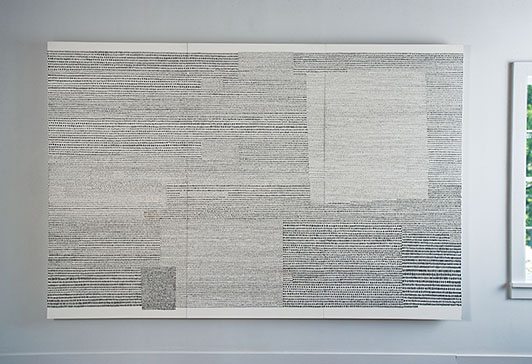
Calculus, Sue Lawty, natural stones on gesso, 78.75″ x 118″, 2010. Photo by Tom Grotta
Sue Lawty
June 16, 11-5pm
The Artworkers Guild, 6 Queen Square, Bloomsbury, London
Woven Tapestry with Sue Lawty”
Website: https://bit.ly/2t3ZZ2J
Susie Gillespie
June 17-21
Yalberton Farm House, Yalberton Road, Paignton, Devon, UK
“Field to Fabric with Susie Gillespie”
Website: selvedge.org
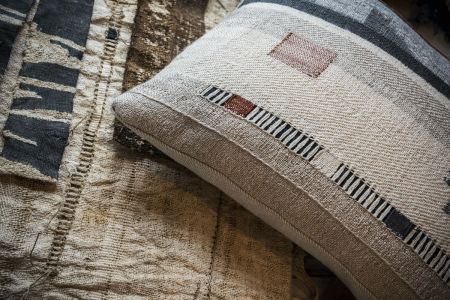
Susie Gillespie Detail
July 30-August 2
South Devon, UK
“Textile Art Techniques: Weaving, Stitching and Dying with Alice Fox and Susie Gillespie”
Website: https://bit.ly/2HJIKc3
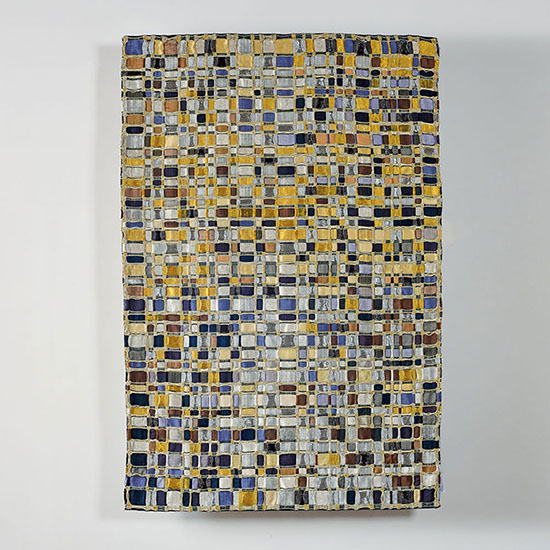
New Nebula, Eduardo Portillo & Mariá Eugenia Dávila, silk,alpaca, moriche palm fiber dyed with Indigo, rumex spp., onion,eucalyptus, acid dyes, copper and metallic yarns, 74” x 49.25”, 2017. Photo by Tom Grotta
Maria and Eduardo Portillo
June 24-July 6
Penland School of Crafts – Textiles Summer Session Three, Bakersville, NC
“Weaving Ideas”
Website: https://bit.ly/2LGP1rB
Carolina Yrarrázaval
July 2
Tama Art Museum, 11th International Shibori Symposium, Tokyo
Talk: “Modern Art Museum Exhibition, Chile”
Website: https://www.11iss.org
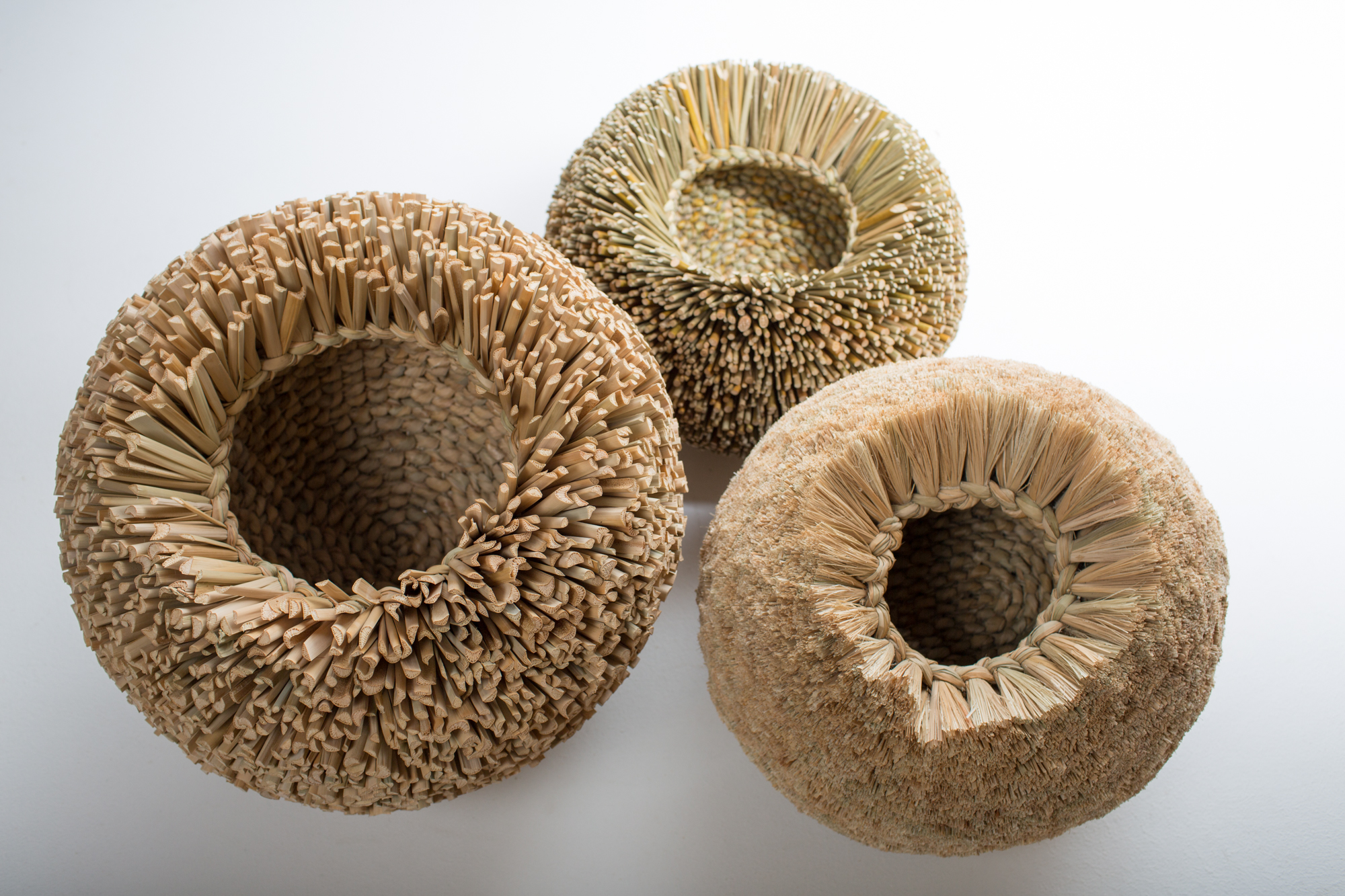
Tim Johnson’s Keeping Time Baskets. Photo by Tim Johnson
Tim Johnson
July 3-4
Järvsö, Sweden
“Finding Fibres – basketmaking with soft materials”
July 16-17, 10-5pm
FlechtSommer – Basketmaking Summer School, Korbmacher-Museum, Dalhausen, Germany
“Looping Techniques with Soft Materials”
Website: https://bit.ly/2JxdOln
July 22 – 27
West Dean College, near Chichester, England
Flexible basketry structures – looping, netting and knotting
Website: https://bit.ly/2y3bblG
Gizella Warburton
July 6 – 8
Hawkwood College, UK
“Presence and Absense”
Website: https://bit.ly
Caroline Bartlett
July 16-18, 10:30-4:30pm
City Lit, London, UK
“Textiles: manipulation, folding and fabric origami”
Website: https://bit.ly/2l3iRv3
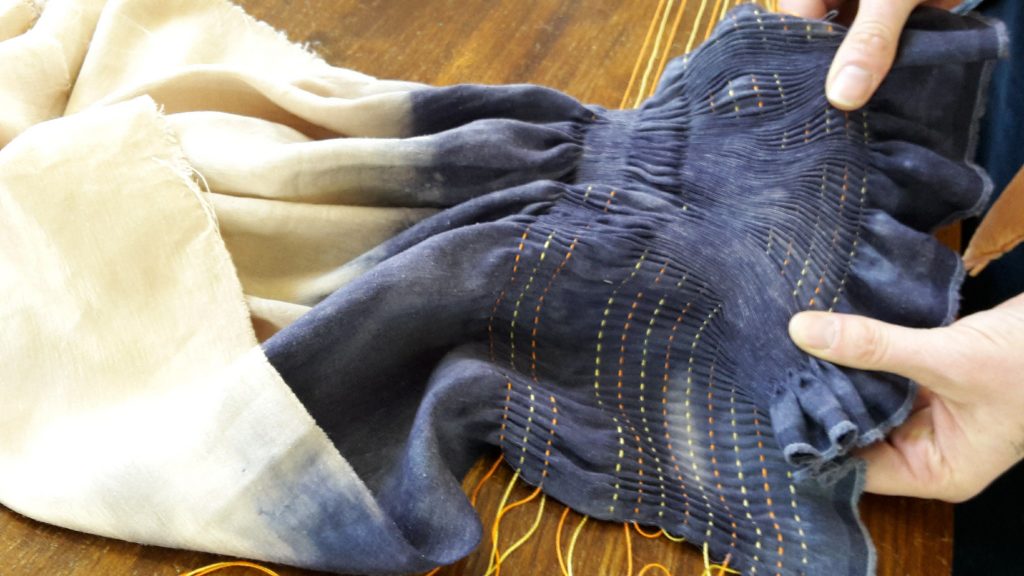
An example of what you can learn at Caroline Bartlett’s “Surfacing: Fold, Pleat, Form”
August 11-17
West Dean College near Chichester, UK
“Reshaping cloth — print and manipulation”
Website: https://bit.ly/2JR0w2w
July 31-August 2
Hawar Textile Institute, Oldeberkoop, Netherlands
“Surfacing: Fold, Pleat, Form”
Website: https://bit.ly/2LFM9Lm
August 27-31
Big Cat Textiles, Newburgh, Scotland
“Between the Folds — Concealing and Revealing with Caroline Bartlett”
Website: https://bit.ly/2JNd4b2
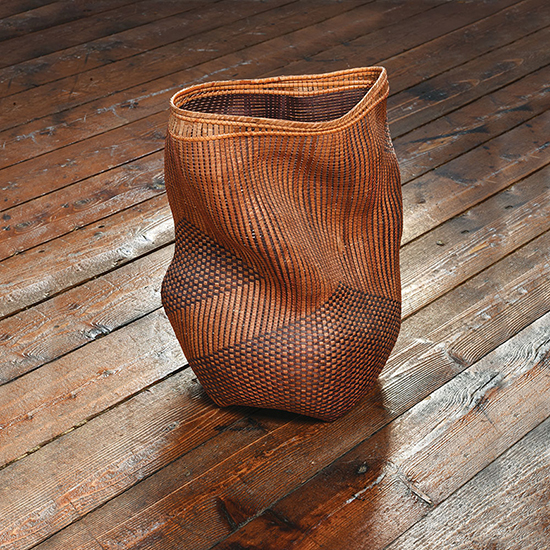
Shady Lane,Polly Adams Sutton,
western red cedar bark, dyed ash, wire, cane
16” x 12” x 9”, 2006. Photo by Tom Grotta
Polly Sutton
August 2-5
Missouri Basketweavers Convention
Talk: August 4, 7pm, “Basketry in Sardinia”
Workshop: August 4-5, “Cedar Knothole Cathead”
August 4, 8am-5pm, August 5, 8am-10am
Website: https://bit.ly/2l6HjvG
Ferne Jacobs
Offering private classes throughout the summer on the fiber techniques of coiling, knotting and twining.
For more information on Jacobs’ offered classes contact her at fernejacobs@gmail.com
Rippling, roiling, teeming with life… Deep, dark, waiting to be explored…
Water has long been a potent influence for artists wishing to explore its majesty and mystery.
For the last several months, browngrotta arts has worked with Jamie Uretsky, Curator and Noelle Foye, Executive Director of the New Bedford Museum of Art/ArtWorks! in Massachusetts. Plunge: explorations from above and below, which examines the influence of water in the work of 16 artists from around the world, is the result.
The multifaceted exhibition combines sculptures, tapestries, installation works, paintings and photography. Each work resides at the intersection of the maker’s fascination with a variety of nautical and natural themes and the artmaking process. Plunge pairs Helena Hernmarck’s monumental woven depiction of tall ships in New York Bay 1884 and Chris Drury’s Double Echo, a print that superimposes a fragment of an echogram from Flight W34 over East Antarctica and an echocardiogram of the pilot’s heartbeat. In other galleries, Heather Hobler’s meditative photographs of seascapes join Karyl Sisson’s “sea creatures” made of domestic objects like zippers and clothespins; Christopher Volpe’s evocative paintings join Grethe Wittrock’s Arctica, a sculpture made from a repurposed sail from the Danish Navy. Unlike most musuem exhibtions, the works in Plunge are all available for sale.
Thirteen of the artists in Plunge, representing five countries, are represented by browngrotta arts: Dona Anderson; Jane Balsgaard; Annette Bellamy; Marian Bijlenga; Birgit Birkjaaer; Chris Drury; Helena Hernmarck; Lawrence LaBianca; Sue Lawty; Judy Mulford; Karyl Sisson; Ulla-Maija Vikman; Grethe Wittrock. Their work, and that of the three other artists in the exhibition, Heather Hobler, Anne Leone and Christopher Volpe, will be included in the catalog for the exhibition, designed and photographed by Tom Grotta. It will be available beginning June 5th at www.browngrotta.com.
Plunge’s opening is tonight Friday, June 2nd at the New Bedford Museum of Art from 6 p.m. to 8 p.m. Jane Balsgaard, one of the artists in Plunge, will attend from Denmark.
The New Bedford Art Museum is great cultural destination for those on the way to the Vineyard, Nantucket or the Cape. You have plenty of time to see it, as the exhibition continues through October 7, 2017. The New Bedford Art Museum/ArtWorks! is located at: 608 Pleasant Street/ New Bedford, MA/02740/508.961.3072/info@newbedfordart.org.
It’s big! It’s beautiful (if we do say so ourselves –and we do)! The catalog for our 30th anniversary is now available on our new shopping cart. The catalog — our 46th volume — contains 196 pages (plus the cover), 186 color photographs of work by 83 artists, artist statements, biographies, details and installation shots.
The essay, is by Janet Koplos, a longtime editor at Art in America magazine, a contributing editor to Fiberarts, and a guest editor of American Craft. She is the author of Contemporary Japanese Sculpture (Abbeville, 1990) and co-author of Makers: A History of American Studio Craft (University of North Carolina Press, 2010). We have included a few sample spreads here. Each includes a full-page image of a work, a detail shot and an artist’s statement. There is additional artists’ biographical information in the back of the book. Still Crazy After All These Years…30 years in art can be purchased at www.browngrotta.com http://store.browngrotta.
com/still-crazy-after-all-these-years-30-years-in-art/. Our shopping cart is mobile-device friendly and we now take PayPal.
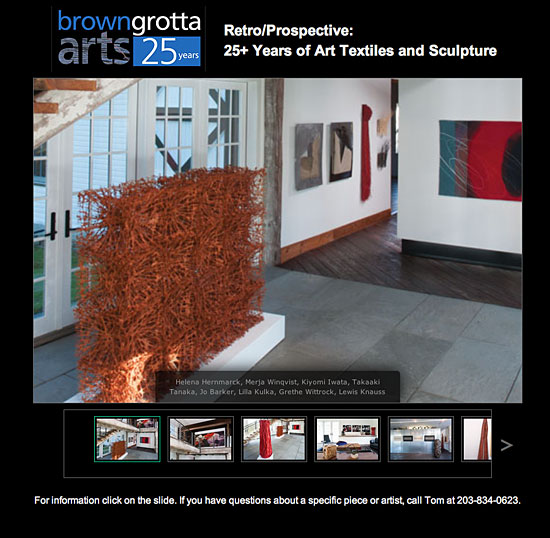 On Monday, November 26th, browngrotta arts will present an online version of our 25th anniversary exhibition,Retro/Prospective: 25+ Years of Art Textiles and Sculpture at browngrotta.com. The comprehensive exhibition highlights browngrotta arts’ 25 years promoting international contemporary art. Viewers can click on any image in the online exhibition to reach a page with more information about the artists and their work.
On Monday, November 26th, browngrotta arts will present an online version of our 25th anniversary exhibition,Retro/Prospective: 25+ Years of Art Textiles and Sculpture at browngrotta.com. The comprehensive exhibition highlights browngrotta arts’ 25 years promoting international contemporary art. Viewers can click on any image in the online exhibition to reach a page with more information about the artists and their work.
“Some works in Retro/Prospective: 25+ Years of Art Textiles and Sculpture reflect the early days of contemporary textile art and sculpture movement,” says Tom Grotta, founder and co-curator at browngrotta arts. “There are also current works by both established and emerging artists, which provide an indication of where the movement is now and where it may be headed.”
Since Monday the 26th is CyberMonday this year, sales of art, books, catalogs, videos or dvds placed online or by telephone that day will be discounted 10% (excluding tax and shipping). In addition, bga will make a donation to the International Child Art Foundation for each sale made from November 24th through December 31, 2012. Visit browngrotta.com. For more information call Tom at 203.834.0623 or email us at art@browngrotta.com.
Lectures, artist booth visits and more. This week’s events include:
April 19th
Opening – SOFA NY
April 20th
1 p.m. to 2 p.m.
Artist booth visit
John McQueen
browngrotta arts booth 208
April 21st
1 p.m. to 2 p.m.
Artist booth visit Norma Minkowitz
At SOFA NY 2012, browngrotta arts will exhibit stone drawings and weavings of lead and linen by UK artist Sue Lawty. Lawty’s constructed pieces and drawings in two and three dimensions explore repetition and interval in raffia, hemp, linen, lead, stone or shadow.
While an artist in residence at the the Victoria and Albert Museum in London in 2005, Lawty collaborated on a project “Concealed-Discovered-Revealed” with the theme of structure and landscape. Lawty used the opportunity to explore and extend her textile vocabulary by creating a large site-specific stone drawing Order, that moved beyond the constraints of a frame. The 6-meter linear pieced drawing of fine stones wavered along the wall’s surface, like a woven structure. Eventually, Origin was removed to The Haymarket Hotel in London.
At SOFA NY, browngrotta arts will exhibit a more recent stone drawing by Lawty, Calculus. At first glance, Calculus appears simple — like a painting of many dots of many sizes. On closer inspection, you realize that the 2 meter by 3 meter surface actually contains hundreds, perhaps thousands, of tiny stones, each smoothed by the sea and hand sorted to create what Emma Crichton-Miller has called a “beautifully choreographed march past the ignored.” Calculus is the Latin word for small stone as well as the name of a branch of mathematics based, like Lawty’s work, on the sum of infinitesimal differences. Lawty’s work has appeared in numerous exhibitions in the UK and abroad, including the International Triennial of Tapestry in Lodz, Poland; the Bankfield Gallery and Museum in Halifax, UK; the Victorian Tapestry Workshop in Melbourne, Australia and the Cheney Cowles Memorial Museum in Spokane, Washington. On Friday, April 20th from 2:30 to 3:30 p.m. Lawty will present a lecture at SOFA NY, Rock – Linen – Lead, about her work and her engagement with remote landscape, geology and the passage of time.
Copyright © 2014-2025 arttextstyle | Powered by WordPress | Design by Iceable Themes

Books Make Great Gifts 2011: Artist Recommendations
This year we asked the artists we represent just one question:
What was the most enjoyed/most inspirational book you read this year?? Here are their wide-ranging replies:
The Absolutely True Diary of a Part-Time Indian by Sherman Alexie, illustrated by Ellen Forney (Little, Brown; National Book Award) . This is a semi-autobiographical novel by award-winning author, poet and film-maker, Sherman Alexie. Alexie has been named one of Granta’s Best Young American Novelists and has been lauded by The Boston Globe as “an important voice in American literature.” He is one of the most well-known and beloved literary writers of his generation, with works such as Reservation Blues and War Dances. He also wrote the screenplay for the film, Smoke Signals, based on a short story from his book, Lone Ranger and Tonto Fistfight in Heaven. In his novel, Alexie tells the heartbreaking, hilarious, and beautifully written story of a young Native American teen, Arnold, as he attempts to break free from the life he was destined to live. Arnold’s drawings illustrate the book.”
Sensual Relations by David Howes (University of Michigan) is Deborah Valoma’s recommendation.